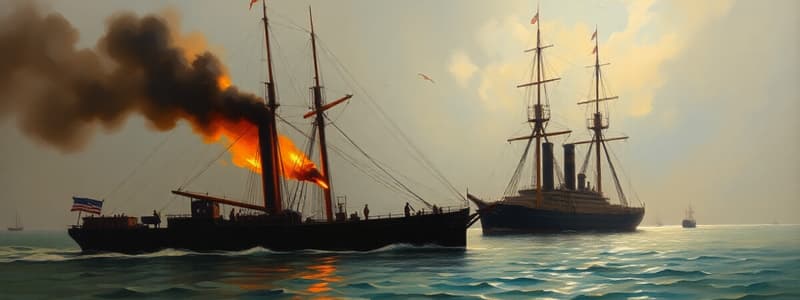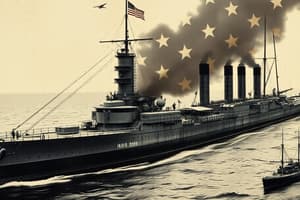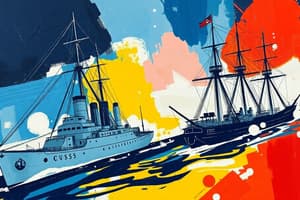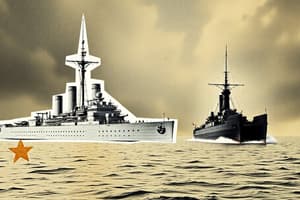Podcast
Questions and Answers
Who ordered Lieutenant William Parker to receive the surrender of Congress?
Who ordered Lieutenant William Parker to receive the surrender of Congress?
- Buchanan (correct)
- Captain John Marston
- Lieutenant Austin Pendergrast
- Lieutenant Catesby ap R.Jones
What ship was assigned to protect Minnesota?
What ship was assigned to protect Minnesota?
- Jamestown
- Congress
- Virginia
- Monitor (correct)
Which officer took command of Virginia after Buchanan was injured?
Which officer took command of Virginia after Buchanan was injured?
- Lieutenant Austin Pendergrast
- Lieutenant William Parker
- Captain John Marston
- Lieutenant Catesby ap R. Jones (correct)
Which Confederate ships converged on the grounded frigate Minnesota?
Which Confederate ships converged on the grounded frigate Minnesota?
What action did Buchanan order after being angered by fire from the shore during the surrender of the Congress?
What action did Buchanan order after being angered by fire from the shore during the surrender of the Congress?
What caused Minnesota to become more deeply stuck in the mud?
What caused Minnesota to become more deeply stuck in the mud?
Which ship raised a white flag to signal surrender?
Which ship raised a white flag to signal surrender?
What was the final outcome of the battle on the first day for the Confederate ironclad Virginia?
What was the final outcome of the battle on the first day for the Confederate ironclad Virginia?
What caused the blower system on the USS Monitor to stop working?
What caused the blower system on the USS Monitor to stop working?
Who played a key role in repairing the blower system on the USS Monitor?
Who played a key role in repairing the blower system on the USS Monitor?
What was the original name of the CSS Virginia?
What was the original name of the CSS Virginia?
What was the average speed of the CSS Virginia as it traveled on the Elizabeth River?
What was the average speed of the CSS Virginia as it traveled on the Elizabeth River?
Which Federal warships were anchored off Newport News?
Which Federal warships were anchored off Newport News?
Which ship did Buchanan primarily fear could damage the Virginia?
Which ship did Buchanan primarily fear could damage the Virginia?
Which action caused the USS Congress to run aground?
Which action caused the USS Congress to run aground?
Which type of vessel was the USS Cumberland?
Which type of vessel was the USS Cumberland?
Who initially contacted Abraham Lincoln with plans for an ironclad?
Who initially contacted Abraham Lincoln with plans for an ironclad?
What was the name of the Confederate ironclad?
What was the name of the Confederate ironclad?
Who was the commander of the USS Monitor?
Who was the commander of the USS Monitor?
Who suggested an attack on New York City?
Who suggested an attack on New York City?
Who ordered the officers and crew to begin putting CSS Virginia in order immediately?
Who ordered the officers and crew to begin putting CSS Virginia in order immediately?
What delayed USS Monitor from leaving New York on March 5, 1862?
What delayed USS Monitor from leaving New York on March 5, 1862?
What was Franklin Buchanan's role in the Confederate Navy?
What was Franklin Buchanan's role in the Confederate Navy?
Who was in awe of the USS Monitor's buoyancy during its maiden voyage?
Who was in awe of the USS Monitor's buoyancy during its maiden voyage?
What capability did the Confederates gain when they took control of the dry dock?
What capability did the Confederates gain when they took control of the dry dock?
Why did the Confederate navy depend on technological advancement?
Why did the Confederate navy depend on technological advancement?
Who was the Confederate secretary of the navy?
Who was the Confederate secretary of the navy?
What was the original name of the Confederate ironclad CSS Virginia?
What was the original name of the Confederate ironclad CSS Virginia?
Who prepared the designs for transforming USS Merrimack?
Who prepared the designs for transforming USS Merrimack?
What slowed down the construction of CSS Virginia?
What slowed down the construction of CSS Virginia?
What was the purpose of CSS Virginia?
What was the purpose of CSS Virginia?
Why was the ironclad board established by the Federals?
Why was the ironclad board established by the Federals?
What type of vessel was the USS Minnesota?
What type of vessel was the USS Minnesota?
Which ship was temporarily removed from the battle due to its commander being injured?
Which ship was temporarily removed from the battle due to its commander being injured?
Why did the CSS Virginia ultimately retreat?
Why did the CSS Virginia ultimately retreat?
What were the orders given to the new commander of the USS Monitor?
What were the orders given to the new commander of the USS Monitor?
Which event occurred on the morning of March 9, 1862?
Which event occurred on the morning of March 9, 1862?
What was the strategic outcome of the battle for the Confederacy?
What was the strategic outcome of the battle for the Confederacy?
What Federal ship had the duty to protect the USS Minnesota?
What Federal ship had the duty to protect the USS Minnesota?
Which action indicated that the battle between the Monitor and Virginia was over?
Which action indicated that the battle between the Monitor and Virginia was over?
What river did the Federal squadron advance up after the destruction of the Confederate ironclad?
What river did the Federal squadron advance up after the destruction of the Confederate ironclad?
The Battle of Hampton Roads involved which type of vessel prominently?
The Battle of Hampton Roads involved which type of vessel prominently?
Which resource provides information about the origins of ordnance testing against armor?
Which resource provides information about the origins of ordnance testing against armor?
Who wrote 'The Battle of Hampton Roads', which is mentioned as an additional resource?
Who wrote 'The Battle of Hampton Roads', which is mentioned as an additional resource?
Which publisher is NOT listed as publishing resources related to the Battle of Hampton Roads?
Which publisher is NOT listed as publishing resources related to the Battle of Hampton Roads?
Which book focuses on new perspectives of the USS Monitor and CSS Virginia?
Which book focuses on new perspectives of the USS Monitor and CSS Virginia?
Which individual's diary is referenced in the notes?
Which individual's diary is referenced in the notes?
Which publication includes Official Records of the Union and Confederate Navies?
Which publication includes Official Records of the Union and Confederate Navies?
Flashcards
Stephen Mallory
Stephen Mallory
Confederate Secretary of the Navy, advocated for ironclad ships.
USS Merrimack
USS Merrimack
The burned-out Union warship salvaged and converted into the CSS Virginia.
CSS Virginia
CSS Virginia
Confederate ironclad ram created from the USS Merrimack.
Hampton Roads
Hampton Roads
Signup and view all the flashcards
Iron plating
Iron plating
Signup and view all the flashcards
Limited iron supply
Limited iron supply
Signup and view all the flashcards
Brooke and Porter
Brooke and Porter
Signup and view all the flashcards
Ironclad Board
Ironclad Board
Signup and view all the flashcards
John Ericsson
John Ericsson
Signup and view all the flashcards
Cornelius Bushnell
Cornelius Bushnell
Signup and view all the flashcards
USS Monitor
USS Monitor
Signup and view all the flashcards
John L. Worden
John L. Worden
Signup and view all the flashcards
Franklin Buchanan
Franklin Buchanan
Signup and view all the flashcards
Alban Stimers
Alban Stimers
Signup and view all the flashcards
Blower System
Blower System
Signup and view all the flashcards
CSS Virginia (formerly Merrimack)
CSS Virginia (formerly Merrimack)
Signup and view all the flashcards
Beaufort and Raleigh
Beaufort and Raleigh
Signup and view all the flashcards
James River Squadron
James River Squadron
Signup and view all the flashcards
Minnesota and Roanoke
Minnesota and Roanoke
Signup and view all the flashcards
Cambridge
Cambridge
Signup and view all the flashcards
USS Congress
USS Congress
Signup and view all the flashcards
Austin Pendergrast
Austin Pendergrast
Signup and view all the flashcards
Burning of Congress
Burning of Congress
Signup and view all the flashcards
Catesby ap R. Jones
Catesby ap R. Jones
Signup and view all the flashcards
Minnesota
Minnesota
Signup and view all the flashcards
John Marston
John Marston
Signup and view all the flashcards
Worden
Worden
Signup and view all the flashcards
Virginia's success
Virginia's success
Signup and view all the flashcards
Battle of Hampton Roads
Battle of Hampton Roads
Signup and view all the flashcards
ORN (Official Records of the Union and Confederate Navies)
ORN (Official Records of the Union and Confederate Navies)
Signup and view all the flashcards
Gideon Welles
Gideon Welles
Signup and view all the flashcards
War of the Rebellion: Official Records
War of the Rebellion: Official Records
Signup and view all the flashcards
James River
James River
Signup and view all the flashcards
Richmond
Richmond
Signup and view all the flashcards
USS Minnesota
USS Minnesota
Signup and view all the flashcards
Lieutenant John Worden
Lieutenant John Worden
Signup and view all the flashcards
Lieutenant S. Dana Greene
Lieutenant S. Dana Greene
Signup and view all the flashcards
Captain Franklin Buchanan Jones
Captain Franklin Buchanan Jones
Signup and view all the flashcards
Strategic Victory (Confederacy)
Strategic Victory (Confederacy)
Signup and view all the flashcards
Study Notes
- The Civil War naval operations and engagements took place at Hampton Roads, Virginia between 8-9 March 1862.
Federal Leadership
- Lieutenant John L. Worden of the United States Navy (USN)
- Lieutenant Samuel D. Greene, USN
Confederate Leadership
- Captain Franklin Buchanan, Confederate States Navy (CSN)
- Lieutenant Catesby ap Roger Jones, CSN
Background
- The steam frigate USS Merrimack was launched in 1855 at Boston Navy Yard, Massachusetts.
- In April 1861, the decommissioned vessel awaited repairs at Gosport Navy Yard in Portsmouth, Virginia.
- On 10 April, Secretary of the Navy Gideon Welles wanted Commodore Charles McCauley to repair the vessel and prepare it for removal to Philiadelphia.
- Welles included a disclaimer to avoid “needless alarm," as Virginia hadn't voted to secede and wanted to avoid expediting their decision
- McCauley responded it would take a month to repair, outraging Welles, who sent Benjamin F. Isherwood, engineer in chief of the Navy, to assess the situation.
- Isherwood finished the work in less than a week and prepared the vessel to depart Norfolk
- The State Convention of Virginia voted for secession one week later.
- A day after the vote, Isherwood advised McCauley that Merrimack read, but McCauley said the ship would not be leaving.
- Welles sent Commodore Hiram Paulding to replace McCauley.
- McCauley chose to abandon the yard, fearing an uprising, burning it to the ground, spiking all the cannons and scuttling all ships, including Merrimack.
- While reinforcements arrived with Paulding, they could only tow one of the remaining ships, the Cumberland, to Fort Monroe.
- The Federals failed to destroy the dry dock, giving the Conferderates the ability to berth and repair ships.
- Major General William Taliaferro and the Virginia state militia took control of the yard after the Pawnee's departure
- The Federal army maintained Fort Monroe, blockading the entrance to Hampton Roads
- The Confederates hoped to break the blockade because they lacked the facilities to build enough ships to outnumber the enemy.
- Confederate secretary of the navy, Stephen Mallory, wrote, "not only does economy but naval success dictate the wisdom and expediency of fighting iron against wood."
- Mallory sent representatives to buy vessels from England and France and intended to salvage the burned Merrimack
- French Forrest reported the successful raising of Merrimack in late May.
- The yard workers converted the burned vessel into a casemate ironclad ram, renaming it CSS Virginia
- Lieutenants John M. Brooke and John L. Porter prepared the designs for the transformation, which included iron plating above the water.
- The plating contributed to the vessel's deep draft of 22 feet.
- It took nine months to construct the vessel meant to defend Hampton Roads and the Confederacy due to limited iron and production.
Prelude
- The Federals felt the need to counter the Confederacy's plans for Merrimack and established the ironclad board.
- The department of the Navy released an advertisement for proposals from designers for “iron-clad steam vessels of war” on 3 August.
- Welles assigned Commodore Hiram Paulding, Commodore Joseph Smith, and Commander Charles H. Davis to the new board for their construction.
- John Ericsson contacted Abraham Lincoln with ironclad plans
- Due to no response, Cornelius Bushnell sought Ericsson out for his opinion on one the ironclad vessels, Galena.
- Ericsson's plans became a reality with the USS Monitor.
- Lieutenant John L. Worden received command of the new ironclad and was excited about its capabilities.
- Worden launched the unfinished ironclad on 30 January 1862 from the New York Navy Yard.
- Welles planned to send the vessel to face the Confederate ironclad at Norfolk when possible.
- The experimental vessel had yet to have sea trials.
- CSS Virginia was launched at Gosport on 17 February.
- French Forrest ordered the officers and crew to begin putting the unfinished vessel in order immediately.
- Mallory named Flag Officer Franklin Buchanan as the Confederate commander on 24 February.
- Buchanan chose Virginia as his flagship, but a lack of gunpowder delayed any attach on the enemy.
- While he waited, Buchanan wrote to General J. Bankhead Magruder on 2 March, asking for cooperation, but Magruder couldn't see an effective way to support Buchanan's attack at Newport News.
- Mallory suggested an attack on New York City, but Buchanan focused on the targets off Newport News Point.
- Worden completed the USS Monitor's sea trials on 5 March 1862
- Delayed by a steering malfunction, he left the next day
- The tug Seth Low departed New York City on 6 March, towing the unstable ironclad down the Atlantic coast toward Hampton Roads.
- Chief engineer Alban Stimers was impressed by the ship's buoyancy.
- A storm on the second day caused water to wash over the deck, stopping the blower system that provided air to those below deck.
- While the turned back into calmer waters, Stimers fixed the blower system and getting the new invention to its first destination.
Battle
- CSS Virginia emerged from the Gosport navy yard on 8 March 1862
- Going an average of five knots, the vessel made slow progress on the Elizabeth River, tended by Beaufort and Raleigh.
- Buchanan saw the five Federal warships when he entered Hampton Roads
- The Cumberland and Congress were anchored off Newport News, near the entrance to the James River
- The St. Lawrence, Minnesota, and Roanoke were near Fort Monroe.
- Buchanan released his towline to Beaufort at 1330 and headed for Cumberland, which he feared might damage Virginia
- The James River Squadron (Patrick Henry, Jamestown, and Teaser) emerged from the James River and headed for the action at Newport News
- The frigates Minnesota and Roanoke headed toward Newport News, and the steamer Cambridge began moving to tow St. Lawrence into position.
- A shot from USS Congress bounced off the armor of the Virginia.
- Beaufort fired at Congress, after which Buchanan fired broadside into Congress but kept his eyes on Cumberland.
- The ram of Virginia hit the starboard side of the large wooden sloop-of-war, and rammed the sinking ship a second time after drawing back and firing again.
- Congress ran aground in attempting to get underway
- The crew of Congress returned crew for an hour before its executive officer, Lieutenant Austin Pendergrast, raised the white flag.
- Buchanan ordered Lieutenant William Parker in Beaufort forward to receiving the surrender, with Raleigh
- Buchanan ordered the officers to be taken as prisoners and the remaining to swim ashore
- Buchanan watched the proceedings when he was wounded by a volley of fire from the shore, ordering the burning of Congress out of anger.
- Command of Virginia passed to Lieutenant Catesby ap R. Jones due to Buchanan's injury.
- Three Federal frigates had run aground trying to move closer to Newport News with the St. Lawrence and Roanoke moved under the protection of Fort Monroe, and Minnesota remained stuck.
- Jones headed for Minnesota after moving from the burning Congress.
- Virginia, Jamestown, and Patrick Henry converged on the grounded frigate
- However, Virginia did not get closer than a mile from the target due to is draft, wheras Jamestown and Patrick Henry were forced to retreat.
- The Confederate squadron move to wait for a new day after the darkness.
- Minnesota's recoil pushed the ship further into the mud.
- A fleet of steam tugs approached the frigate, and working all night, attempted to drag it off the bar.
- Worden and Monitor reported to Captain John Marston, Roanoke's commanding officer, on the evening of 8 March.
- Marston assigned Monitor to the protection of Minnesota.
- Congress exploded shortly after midnight.
- The Virginia destroyed two warships on its first day of battle.
- Jones brought Virginia to finish the carnage on the morning of 9 March 1862.
- Expecting no adversary, Jones did not see an an ironclad appoarchig from behind
- Monitor opened fire, forcing all the wooden vessels except Virginia to retreat
- The ships circled each for the next four hours and an explosion injured Worden.
- Temporarily blinded, Worden handed command over to Lieutenant S. Dana Greene.
- Monitor withdrew during the transfer and Jones' officers retired, with the new commander protecting the Minnesota.
- Virginia returned to the yard for repairs
- Tugs freed Minnesota during the night
- It was clear the battle was over when Virginia failed to appear.
Aftermath
- No clear winner was determined.
- With the withdrawal of Virginia, the danger to Minnesota was temporarily removed and the frigate refloated on 10 March.
- The Federal navy reached a tactical victory as the Monitor protected Minnesota, preventing Virginia from destroying it.
- The battle provided a strategic victory for the Confederacy, but not complete.
- Despite the destruction of Cumberland and Congress, the Federal army retained Fort Monroe.
- The Federal fleet withdrew most of its vessels to the open sea, but the blockade stayed in effect.
- The Confederate ironclad blocked any Federal access to the James River, causing Major General George McClellan to need a new operational approach because the ironclad blocked access to the James.
- Pressured by Washington, McClellan planned to land at Fort Monroe and move overland towards Richmond.
- He sought reassurance from Gustavus Fox that Monitor was a match for Virginia, but Fox warned against full reliance on one vessel.
- McClellan landed his army and supplies at Fort Monroe on 17 March 1862 and started a new campaign to take Richmond.
- Virginia returned to the dry dock three days after leaving, and Flag Officer Josiah Tattnall assumed command when Buchanan's wounds didn't allow to resume his command.
- Tattnall knew the enemy would attempt to draw out the ship to ram it, so Virginia guarded the entrance to the James River and impeding any Federal advance to the Confederate capital.
- The Federals prepared for their next opportunity to engage Virginia, and Flag Officer Louis M. Goldsborough put his fleet in Hampton Roads.
- On 11 April, Virginia reemerged with four gunboats and two tugs, stopping near Sewell's Point to see if the Monitor accepted his challenge.
- Monitor's Lieutenant Commanding William Jeffers resisted order to attack.
- Both deterred for the other as Confederate forces fell back toward Richmond.
- Virginia was unable to ascend the James River due to its depeth.
- Tattnall scuttled the vessel on 11 May 1862, later being court-martialed and acquitted.
- The Federal squadron advanced up the James River toward Richmond with the destruction of the Confederate ironclad.
Studying That Suits You
Use AI to generate personalized quizzes and flashcards to suit your learning preferences.




